To choose a good bipod for your needs, you’ll need to consider the way you intend to use it, as well as the things you want the scope to do.
We’ll cover some of the best bipods on the market below, and will also explain some of the crucial decisions you’ll need to make when picking one out.
DISCLOSURE: As an Amazon Associate I earn from qualifying purchases. Links in this article are affiliate links. If you click on a link we may earn a commission if you make a purchase, at no additional cost to you.
The 8 Top Bipods: Outdoor Empire Reviews
Of the eight bipods we review in this article, these are our top recommendations for bipods:
- Best for the money: UTG Hi Pro Shooters Bipod
- AR-15 bipod: UTG Recon Flex Keymod Bipod
- Best for long range shooting: Accu-Shot BT46-LW17 PSR Atlas Bipod
- Best for hunting: Harris Engineering S-LM Hinged Bipod
Looking for a specific feature? Check out our quick-reference chart below:
| Product | 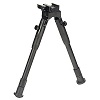 | 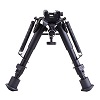 |  | 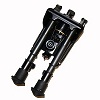 | 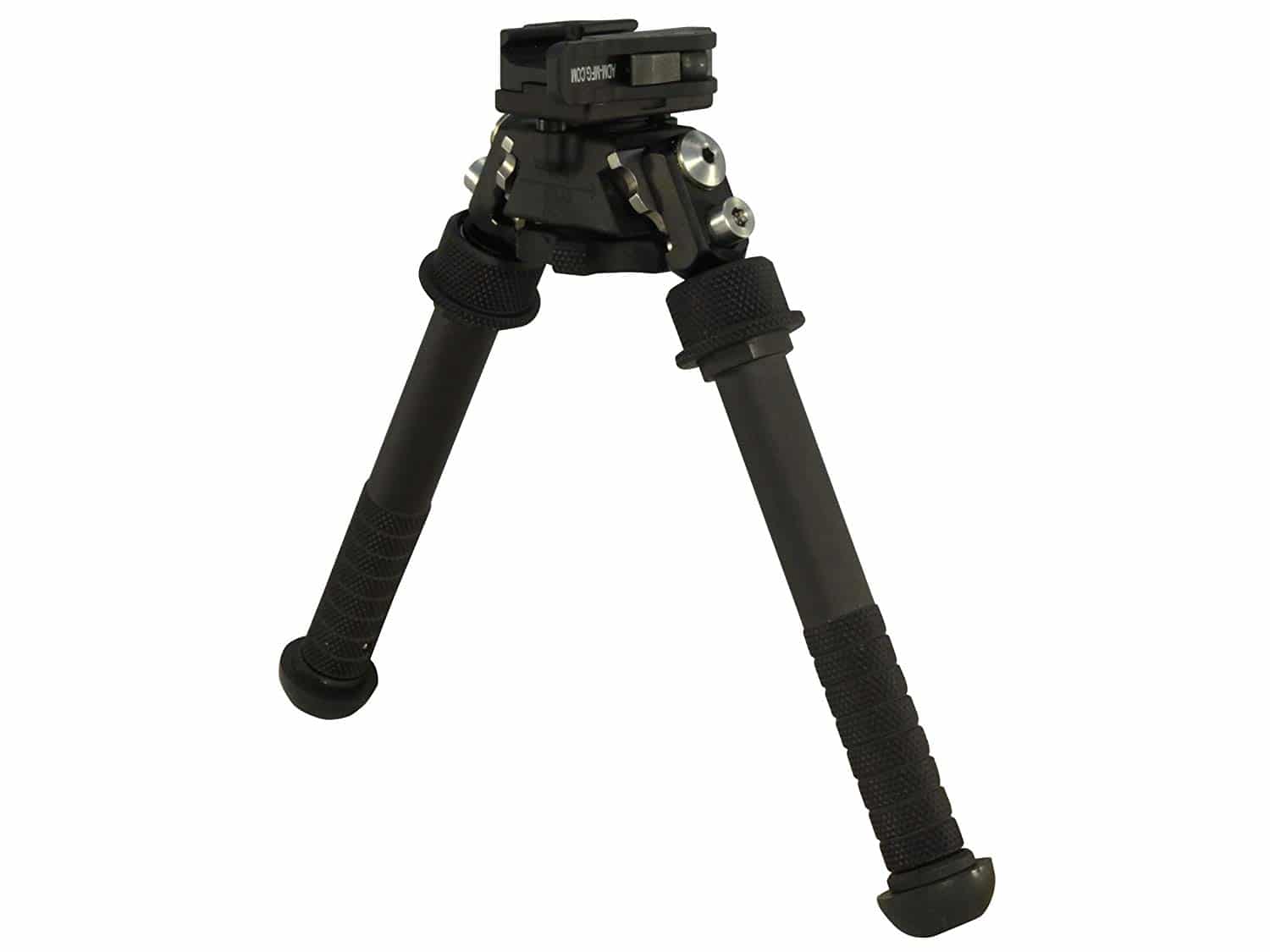 | 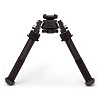 | 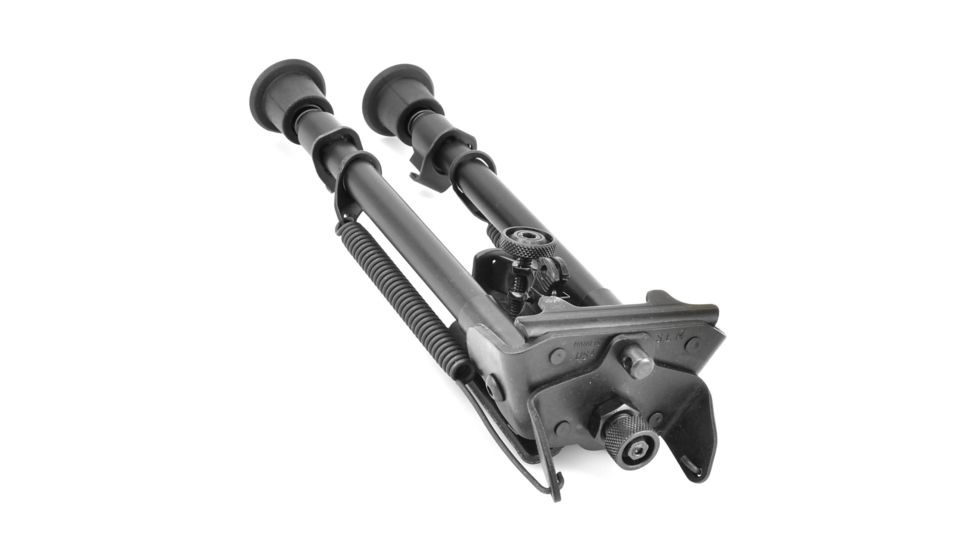 | 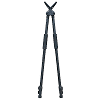 |
|---|---|---|---|---|---|---|---|---|
| Height | 8.7 - 10.6 in | 9 - 13 in | 5.7 - 8 in | 6 - 9 in | 5 - 9 in | 4.75 - 9 in | 9 - 13 in | 22 - 62 in |
| Weight | 11.1 oz | under 0.78 lbs | 10.8 oz | 13 oz | 11.42 oz | 11 oz | 14 oz | 1.5 lbs |
| Material | Metal | Aluminum | Aircraft Grade Aluminum Construction | Aluminum | 6061 T6 Aluminum | T6061 Aluminum | Aluminum Alloy with some Steel Parts | Aluminum |
| Independent Adjustment | Yes | Yes | Yes | Yes | Yes | Yes | Yes | No |
| Mounting Option | - Picatinny rail - Sling swivel | Picatinny rail | Direct Keymod attachment | Sling swivel stud | Picatinny rail | Picatinny rail | Sling Swivel Mount | V rest |
| Cost | Check Price | Check Price | Check Price | Check Price | Check Price | Check Price | Check Price | Check Price |
Best Bipods for the Money
No matter what type of shooting accessory you are seeking, you’ll want to get one that provides great value. Both of the following bipods are high-quality units, without the high-end price tag.
1. UTG Hi Pro Shooters Bipod
UTG has started to step up their game when it comes to producing quality, but affordable accessories for firearms.
The Hi Pro Shooter’s Bipod is quite light and offers a unique option for leg height. It can extend from 8.7 inches to 10.6 inches.
You don’t have a lot of variance between height options, but you do have a very light bipod that’s a good choice for both hunting and bench rest shooting.
It comes with attachments for both picatinny rails and sling swivel studs. It’s easy to attach this bipod to just about any weapon. The Hi Pro also pans about twenty degrees total.
It doesn’t cant, but at this price range, it’s impressive that it pans.
The legs fold for easy carry and are locked into place with a posi lock. The bipod legs are independently adjustable and fitted with rubberized feet for a sure grip.
- Height – 8.7 to 10.6 Inches
- Mounting Option – Picatinny Rails / Sling Swivels
- Independent Adjustment? – Yes
2. CVLife Tactical Rifle Bipod
If you are rocking and rolling with a modern sporting rifle like the AR-15 or AR 10 and are looking for a bipod on a budget the CVLife Tactical Rifle bipod is one solid choice.
It is designed to be fitted with a picatinny rail system and gives you 9 to 13 inches of height.
The legs are independently adjustable and have five different positions for height. To adjust the bipod, you simply push a button and pull the legs downwards.
The CVLife Tactical rifle bipod features a unique swivel head. It allows you 360 degrees of panning capability. It allows the rifle to scan left to right as far as necessary.
This gives you an amazing ability to track moving targets or to comfortably surveil an entire landscape. The CVLife bipod is made entirely of anodized aluminum and is available at a great price.
- Height – 9 to 13 Inches
- Mounting Option – Picatinny Rail
- Independent Adjustment? – Yes
Best AR-15 bipods
Sometimes, only the best will do. If you are looking for the best available bipod for your AR-15, the two models below are sure to fit the bill.
3. UTG Recon Flex Keymod Bipod
This is a fascinating bipod and I’m impressed UTG came up with the design. The modern AR-15 handguard is changing. Modularity and low weight are becoming key.
Modular handguards feature slots that allow the user to mount a rail only where they need it, or to directly mount accessories to a rail. The Recon Flex bipod attaches directly to the handguard via keymod attachments.
This makes it one of the lightest bipods on the market because it lacks a centerpiece. It still provides up to 8 inches in height, with a minimum height of 5.7 inches. The legs can be independently adjusted, and each leg has 5 different positions.
By being attached directly to the rail system you reduce weight and lower the weapon’s profile while maintaining stability and accuracy.
The Recon Flex bipods is a modern option for a modern rifle. It folds up nice and compact, and only requires 5 keymod slots per leg.
- Height – 5.7 to 8 Inches
- Mounting Option – Direct Keymod attachment
- Independent Adjustment? – Yes
4. Harris S-BRM Bipod
Compare prices at: Sportsman’s Warehouse, Brownells, Primary Arms
The Harris Engineering bipod doesn’t seem like it’s made for the AR-15, but you’d be dead wrong. It does attach to a sling swivel, so an adapter is needed for mounting to a rail system.
It’s the military’s choice of a bipod and has found its way on accurized M16s known as Mk 12s. It’s performed in two wars near flawlessly on the military’s version of the AR-15.
It’s a tough and dependable bipod that’s proven and reliable.
The legs extend 6 to 9 inches and can be extended independently. They are notched in 1-inch increments and it’s easy to extend the legs. They remain functional even when caked with mud and dust.
Harris bipods are incredibly lightweight and are spring loaded for easy and stable folding. They aren’t the cheapest, but they are some of the most proven bipods on the planet.
- Height – 6 to 9 Inches
- Mounting Option – Sling Swivel Stud
- Independent Adjustment? – Yes
Best Bipods for Long Range Shooting
Long-range shooting all but requires a good bipod. We’ll examine the characteristics and features of two of the best models below.
5. Accu-Shot BT46-LW17 PSR Atlas Bipod
Compare prices at: Sportsman’s Warehouse
The Accu-Shot BT46-LW17 PSR Atlas Bipod is highly rated by its users. It is made of Mil-Spec Type III hard-coat anodized aluminum.
All stainless-steel components have also been heat treated for durability. The swivel feature allows the user to achieve some movement in their rifle or scan the landscape without having to readjust the legs.
This bipod is perfect for long-range shooting because of its sturdiness and adjustability. The Accu-Shot Atlas Bipod can be mounted directly to any 1913 style Picatinny rail with the included ADM-170-S adaptor.
Pros:
- Made of high-quality aluminum
- Swivel feature allows for movement
- Can be mounted to 1913 style Picatinny rail
- Five locking positions
Cons:
- Expensive
- Users who purchased outside of Atlas site complain of forged products
The Accu-Shot BT46-LW17 PSR Atlas Bipod is a well-made product that impresses its users time and time again. This bipod is the perfect lifelong accessory to anyone wishing to increase the accuracy and consistency of their long-range shooting.
6. BT10 V8 Atlas Bipod
Compare prices at: Sportsman’s Warehouse
B&T makes some of the most revolutionary bipods on the market. The BT10 model is designed for long-range precision. It allows the shooter to get nice and low. The lower you get, the more stable the position is likely to be.
The Accu-Shot Atlas Bipod BT10 offers an impressive range of extension. It goes from 4.75 inches the 9 inches. 4.75 inches puts you quite close to the ground, and at 9 inches you’re capable of getting over most ground cover.
Atlas bipods are renowned for their stability and robust nature. They are quite strong and can support an impressive array of weapons.
The Atlas bipod features 15 degrees of both cant and pan which gives shooters the ability to dial in the weapon and compensate for both drop and wind.
The legs can be positioned 45 degrees rearward, 90 degrees downward, and 45 degrees forward. This allows you to work any ground you come across. If price isn’t an issue the Atlas Bipod BT10 is an excellent model for long range shooting.
- Height – 4.75 to 9 Inches
- Mounting Option – Picatinny Rail
- Independent Adjustment? – Yes
Best Bipods For Hunting
7. Harris Engineering S-LM Hinged Bipod
If you are looking for a dependable hunting bipod, the Harris Engineering S-LM is a quality investment.
This bipod eliminates tension or looseness with its hinged base and buff springs. The Harris bipod is perfect for hunting because it can easily level on uneven ground.
There are seven available height adjustments to choose from, ranging from 9 to 13 inches. The bipod also swivels and has legs that eject by spring action.
Pros:
- Hinged base and buff springs
- Easily levels on uneven ground
- Seven height adjustments from 9 to 13 inches
- Swivels and pivots
- Smooth operation
Cons:
- Needs and adaptor to mount on a Picatinny rail
- Would benefit from a bipod lock because of the hinged base design
- Users who purchased off the Harris site warn of counterfeit products
The Harris Engineering S-LM Hinged Base 9-13 Inch Bipod is an ideal bipod for hunters who want to improve their accuracy in the field while keeping their weapon out of the dirt, mud, or grass.
8. Do-All Outdoors Dead on Bipod Shooting Stick
When it comes to hunting you can’t always pick and choose where you get to set up your position. The Do-All Outdoors Bipod shooting stick allows shooters to assume a seat or kneeling position while stabilizing their weapon.
This design lets you set up anywhere at any time. The stick itself isn’t attached to your rifle but acts as a rest for your rifle.
This bipod shooting stick extends from 22 to 62 inches, and the bipod itself can be adjusted with a single hand. The bipod shooting stick is sturdy and made from aluminum so it’s lightweight and durable.
At the very top your gun V can actually swivel so you can track game without having to readjust. It’s also an affordable and adjustable option.
Shooting sticks aren’t traditional bipods, but they do offer shooters an alternative option that’s handy as hell.
- Height – 22 – 62 Inches
- Mounting Option – V Rest
- Independent Adjustment? – No
The Significance of the Right Bipod
Stability builds confidence when you are behind a rifle. If the sights aren’t moving and you can see the target you can be pretty confident that you’ll hit what you’re aiming at. Stability is the key to successful shooting.
The goal of a bipod is to provide you with that confidence building stability you need to take those difficult shots.
Putting yourself behind a bipod that shakes, rattles and rolls is a great way to waste your time and your ammunition. That’s what happens when you start with a crappy bipod.
It’s easy to avoid a crappy bipod. What’s harder is avoiding the wrong bipod. A bad bipod can be avoided through internet reviews, or by buying one of the above-suggested bipods.
Again, the problem comes with choosing the wrong bipod for the wrong platform, or the not understanding the features enough to understand what you are getting.
-
-
- A heavy and tall bipod on a lightweight, quick shooting rifle is one example of a potentially good bipod on the wrong platform.
- A short bipod on a rifle with a long magazine is another example of a potentially good bipod on the wrong platform.
-
Check the video to know the advantages and some disadvantages of bipods.
Important Choosing Factors
When you start trying to narrow down your selections and make your choice, you’ll need to consider a few important criteria. We’ll discuss some of the most important factors that should play a role in your decision-making process below.
Materials Used
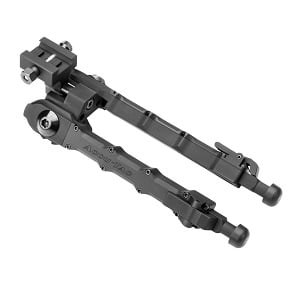
Bipods come primarily made from aluminum, but some are built from polymer materials. Personally, I’m never going to use a bipod made from anything other than aircraft grade aluminum.
Of course, polymer materials can be present, but the legs and main body need to be made from aluminum if you are tossing this on a firearm.
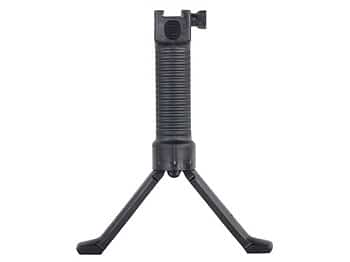
Concessions can be made for airguns, but for rifles, I’d never trust a bipod with polymer legs for serious shooting.
Bipods not only have to support the weight of the rifle, but they have to deal with the recoil as well. How long with polymer last against a 30-06 rifle? I’d prefer an aluminum bipod that I can trust, and that I don’t have to treat with kid gloves.
This is going to affect the overall price of my bipod, but I think paying a little extra is worth it. Polymer bipods are not something I’d trust for long-term use.
With aluminum bipods, you want a corrosion resistant finish, the most common being anodized aluminum. There is also parkerized and cerakoted options.
UTG even does a rubberized armor over their aluminum bipods that functions reportedly very well.
Weight Factor
As someone who prefers aluminum I have to accept my bipod is going to be slightly heavier than polymer models. Balancing weight with quality can often be tricky.
While most of us want to go lightweight with our guns and gear, we need to place a higher focus on balance than on pure weight.
What I mean is if the rifle itself is already a gun designed to be fired from a bipod then you should go with a heavier, more robust bipod.
Guns in calibers like 338 Lapua Magnum, 416 Barrett, and of course 50 BMG are designed to be fired from a resting position.
Offhand shots with these rifles are uncommon, so a lightweight bipod isn’t necessarily needed. You want a stronger and therefore heavier bipod due to the rifle’s increased weight and recoil.
A lighter rifle like a Remington 700 in 308 or an AR-15 needs a lighter bipod to make unsupported shots easy. A heavier bipod on one of these rifles will throw the balance off when being used in an unsupported position.
The weight will pull the barrel down and put more stress on the shooter.
When contemplating weight versus robustness look at the rifle the bipod is being attached to first.
Attachment Device
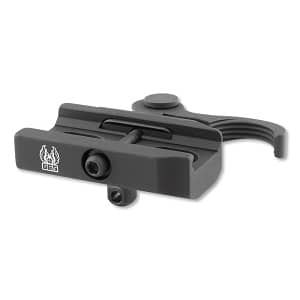
How exactly can you attach the bipod to the gun? This will largely depend on your gun.
1. Some are going to be outfitted with picatinny rails, and a wide variety of bipods strap onto pic rails without issue. Other, more traditional rifles, don’t often have picatinny rails so you’ll rely on the sling swivel to attach a bipod.
Is one better than the other? Picatinny rails models tend to be quicker and easier to attach, but both are quite stable.
Now if you find a bipod that only accepts the attachment system you don’t have, and you want that bipod, you do have options.
2. Adapters exist to add a sling swivel to a picatinny rail and a picatinny rail to a sling swivel. Don’t be afraid to choose one or the other.
3. There are also shooting stick style bipods that bear mentioning. These long and tall bipods do not attach to the rifle but are equipped with a rest to set the rifle into.
These are a good choice for shooters who want to shoot in the seated position, but also want to keep their rifles light and handy for offhand shots.
4. Alternatively, there is a fourth means to attach a bipod that I can’t recommend. It attaches the bipod directly to the barrel.
Sure, it’s universal, but it’s not very stable. It also puts pressure on the barrel and will likely cause shots to ‘walk’ as the barrel heats up. These bipods are junk, and I recommend you stay away from them.
Independent Adjusting Legs
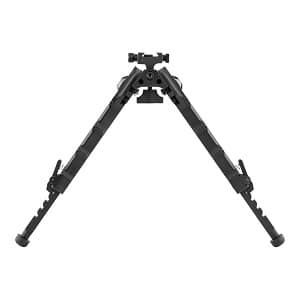
You may not have that perfectly flat piece of earth to take your shot, and independent adjusting legs allow you to compensate for that. This is a must-have for tactical shooters and hunters. It’s not a big deal for bench-rest shooters though.
With independently adjustable legs you can use almost any piece of ground to stabilize your weapon and can set up virtually anywhere. Independent adjustable legs do add some cost and complication to your bipod, but it’s worth it as far as I’m concerned.
These legs do require time to adjust correctly, and standard bipods are a bit quicker to get in action when the ground is right.
Panning and Cant
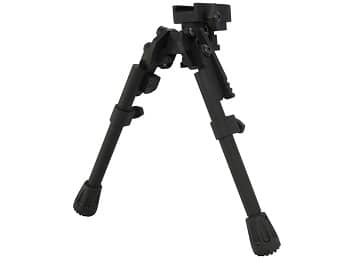
Panning
Panning is the ability for the bipod to swivel left and right. This is often measured in degrees. This is a must-have if you are shooting at moving targets or tracking animals.
The ability to pan allows you to make those micro corrections without having to move the entire rifle and bipod.
Cant
Cant is the rifle’s ability to move up and down on the bipod.
Canting gives you the ability to make those same micro corrections as panning. This allows you to pick and choose your shot on a target. It’s especially handy if you need to compensate for extreme distances and bullet drop.
Not all bipods are equipped with this feature. Like most features, it will add cost to the design, as well as make it a bit more complicated.
The ability to pan and cant is often found on tactical bipods, especially those that are on the higher end of the market.
Height and Leg Length
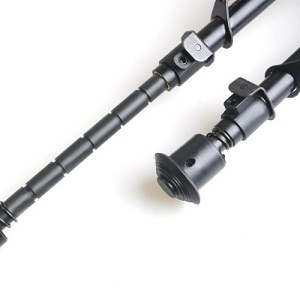
Shooters using modern sporting rifles with standard cap 30 round magazines are going to need to be higher than shooters with bolt action rifles.
The long magazine creates the need for a higher bipod, so the magazine isn’t resting on the ground and so the shooter can reload the rifle.
Tactical shooters stuck wearing body armor should also be concerned about bipod height. Body armor pushes you off the ground and to shoot comfortably, you’ll need a taller bipod.
Hunters and outdoor shooters who shoot in the snow may also want or need a taller bipod to compensate for the snow while shooting.
The same could be said for those shooting over grassy areas. You need to stay above the grass so that a taller bipod may be needed.
Tactical shooters aren’t just restricted to the ground and may wind up in odd positions and situations that require a little more length on their end and versatility should be a serious consideration.
Bipods come in the following heights. Exceptions exist, but these are the most general heights, including adjustable bipods.
-
-
- 6 to 9 inches – These bipods are best suited for shooting on a solid bench over the ground. At its maximum height, it is a decent choice for ground shooting.
-
-
-
- 9 to 13 inches – This height is a good choice for regular shooters who aren’t wearing armor, and want to shoot off the ground. 9 to 13 inches provides enough clearance for most AR magazines and also allows shooters to remain comfortable when shooting for the ground at any height.
-
-
-
- 13 to 24 inches – When it comes to shooting with body armor, and an AR this is likely the best choice. It’s also an excellent choice for hunting over deep snow and high grass. 13 to 24 inches also allows tactical shooters to shoot in odd positions.
-
-
-
- 14 – 30 inches – These massive bipods allow shooters to shoot in the sitting or kneeling position. This may be a must-have in hilly or mountainous environments where traditional prone positions are impossible. These bipods allow you to assume the sitting or kneeling position and take stable shots over long distances with ease.
-
Check the video for more tips on the bipod height and length that is best for certain situations.
Multi-Use Bipods
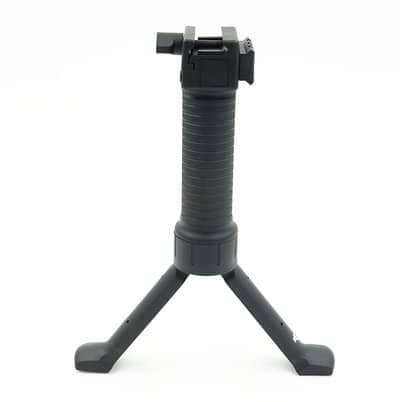
Multi-use bipods are handy but do not provide the most stable platform. These bipods won’t have adjustable height, independent legs, or the ability to pan or cant.
They don’t sound great but can be quite handy for rifles built for speed. They allow you to stabilize short range shots, and are perfect for shooters who find themselves on the move more than they do in the prone.
They also tend to be pretty affordable and perfect for close quarters carbines occasionally called into more precise roles.
Leading Bipod Brands
As with any other hunting product, you’ll notice that some brands have tendencies that remain constant across entire product categories. Some of the most notable bipod manufacturers and brands are detailed below.
Accu Shot Atlas Bipods
B&T’s Accu Shots Atlas bipods introduced some of the most revolutionary bipods ever seen. They were one of the first companies to introduce panning, canting, and multiple positioning legs on a lightweight bipod platform.
The legs can lock at a 45 degree rearward or forward to adjust to any terrain possible.
In a very short period, their bipods became the favorite of professional shooters in the competition circuit, the military, and with hunters worldwide. The Accu Shot series are professional grade bipods that are priced accordingly.
Accu Shot Atlas bipods cover every classification of a rifle. They make bipods capable of handling 50 BMG rifles with ease as well as bipods perfectly suited for lightweight AR style rifles. They are durable and reliable, on top of being stable and easy to use.
Stability is one of the most important factors to consider when choosing a bipod. Atlas bipods can’t be pigeonholed to one particular task, but they do make exceptional long-range precision shooting bipods.
The PSR series, in particular, are best suited for long-range tactical shooting and are a favorite of both police and military snipers. Atlas bipods are not for the plinker or recreational shooter, they are for the hardcore shooter.
Harris
Harris bipods and I go back a long time. We served in Afghanistan together, and they never failed to deliver in combat. Harris bipods as a company make just about everything you can imagine for bipods.
This includes bipods of course, as well as multiple heads for their modular models, and a wide variety of mounts.
Harris bipods also produce mounting systems for:
-
-
- keymod rails
- M-Lok rails
- shotguns
- picatinny rails
- sling swivels
-
Their mounts are nice, but their bipods are the star of the show. They are well built, rugged, and dependable for the tactical shooter.
Harris makes a bipod for just about any firearm, which includes rifles like the M14, the Remington 700, and AR-15.
Harris produces bipods at a variety of different heights, with each being adjustable and easy to manipulate with one hand. Their bipods have taken the tactical market by storm due to their widespread adoption by the United States Marine Corps.
Harris bipods are all priced exceptionally well when you consider their quality. They are often available for less than a hundred dollars, making them one of the most affordable premium options for tactical shooters.
GG&G
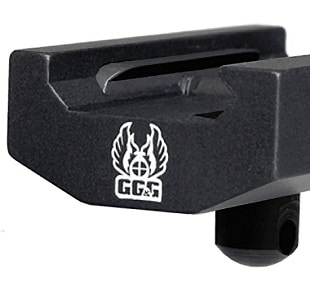
-
-
- 50 BMG
- 416 Barrett
- 408 Cheytac
-
These massive bipods are robust enough to make a California legislator squirm in his chair. They provide a durable and stable platform for big bore rifles that suck up the recoil of these guns without a second thought.
GG&G isn’t a one trick pony. They produce nine different bipods with models designed for bolt action hunting rifles, modern sporting rails, and even modern modular rail attachments.
GG&G produces mounts for both M-Lok and Keymod rail systems that allow you to bypass the rail system and mount directly to the handguard.
GG&G’s bipods are used around the world with elite shooters in competitive shooting and tactical shooting. It’s not unusual to see GG&G bipods at competitions like the King of Two Miles.
Their bipods are used and endorsed by firearms training schools like Thunder Ranch and Gunsite. GG&G bipods are made for the most demanding long range, big bore shooters on the firing line.
Staying Stable
Shooting with a bipod for the first time can be a love it or hate experience.
There is rarely any middle ground, and those love or hate experiences are often based on what bipod is being used.
If you follow our guide above, you’ll find the right bipod for the right gun and the right situation. Stay stable, and shoot straight.

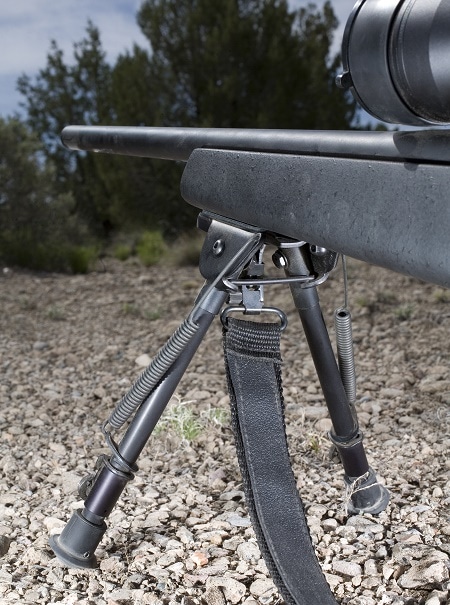
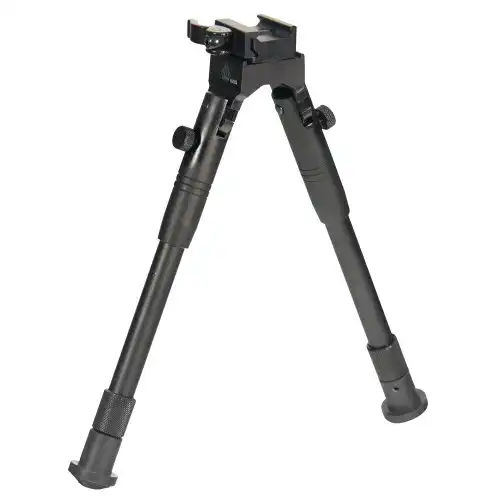
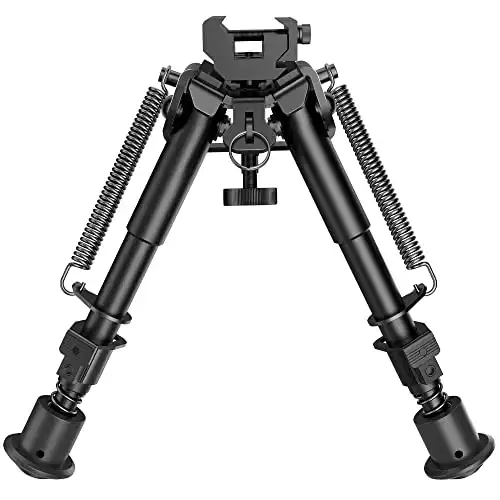
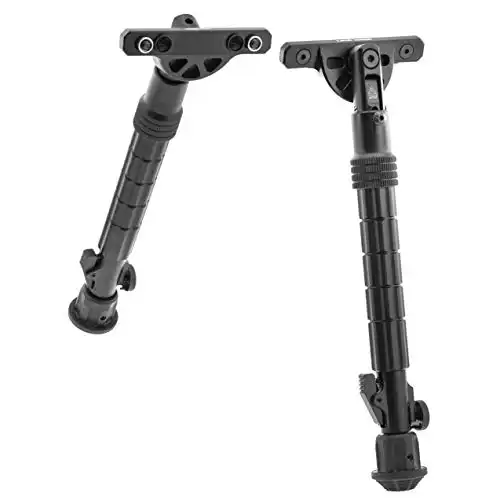
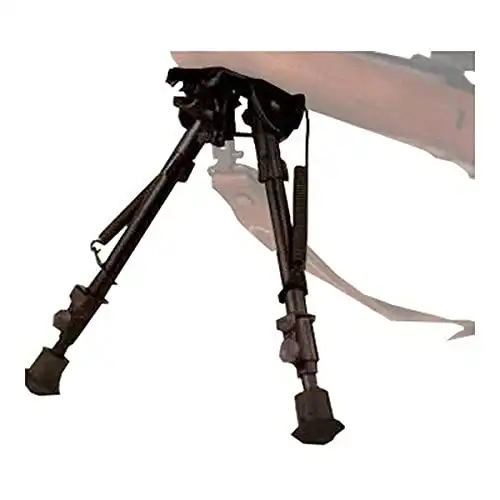
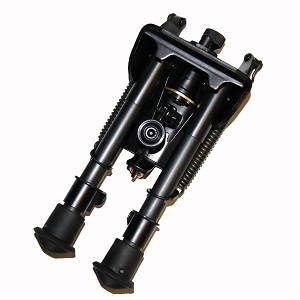
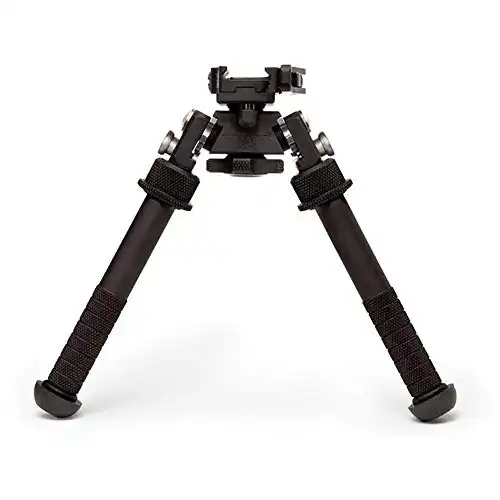
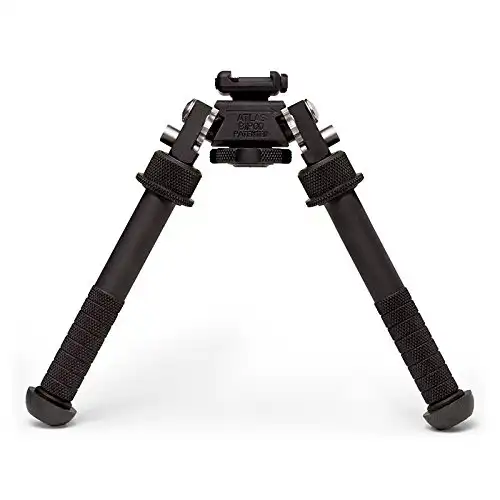
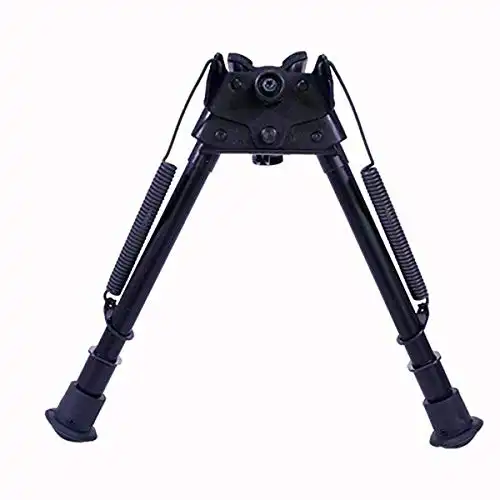
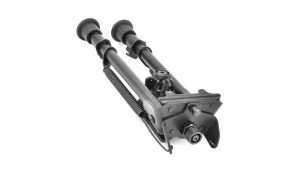

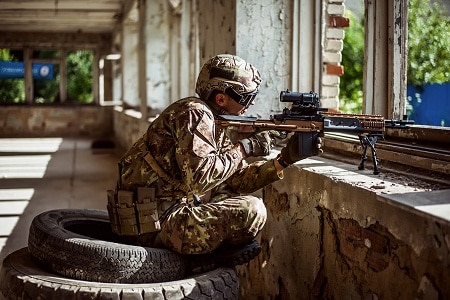
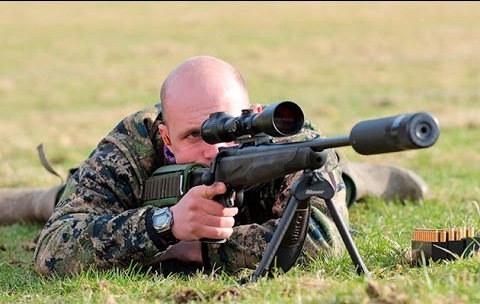
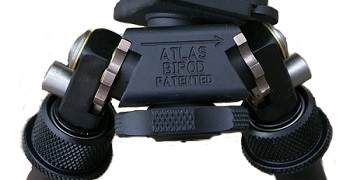
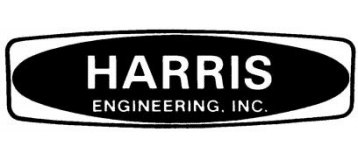
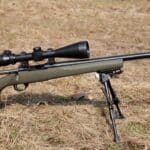
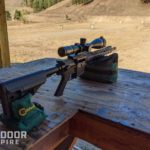

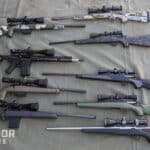
Comments are closed.